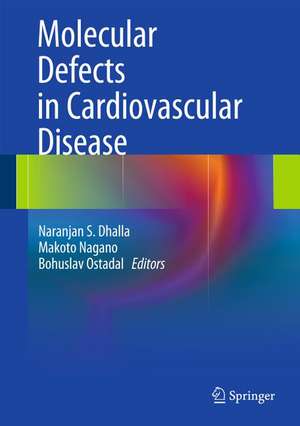Molecular Defects in Cardiovascular Disease
Editat de Naranjan S. Dhalla, Makoto Nagano, Bohuslav Ostadalen Limba Engleză Hardback – 9 aug 2011
A necessary resource for clinicians and researchers, this book elucidates the experimental basis of the practice of cardiology. It is the culmination of our advances in the understanding of cardiovascular molecular biology and a blueprint for the efficacious use of targeted therapies.
| Toate formatele și edițiile | Preț | Express |
|---|---|---|
| Paperback (1) | 789.96 lei 6-8 săpt. | |
| Springer – 23 aug 2016 | 789.96 lei 6-8 săpt. | |
| Hardback (1) | 1111.26 lei 6-8 săpt. | |
| Springer – 9 aug 2011 | 1111.26 lei 6-8 săpt. |
Preț: 1111.26 lei
Preț vechi: 1169.74 lei
-5% Nou
Puncte Express: 1667
Preț estimativ în valută:
212.64€ • 221.58$ • 176.06£
212.64€ • 221.58$ • 176.06£
Carte tipărită la comandă
Livrare economică 03-17 aprilie
Preluare comenzi: 021 569.72.76
Specificații
ISBN-13: 9781441971296
ISBN-10: 1441971297
Pagini: 500
Ilustrații: XVIII, 382 p. 78 illus., 31 illus. in color.
Dimensiuni: 178 x 254 x 28 mm
Greutate: 0.84 kg
Ediția:2011
Editura: Springer
Colecția Springer
Locul publicării:New York, NY, United States
ISBN-10: 1441971297
Pagini: 500
Ilustrații: XVIII, 382 p. 78 illus., 31 illus. in color.
Dimensiuni: 178 x 254 x 28 mm
Greutate: 0.84 kg
Ediția:2011
Editura: Springer
Colecția Springer
Locul publicării:New York, NY, United States
Public țintă
Professional/practitionerCuprins
Calcium overloading-induced oxidative stress-mediated cellular and subcellular remodeling.- Intracellular MMP-2: Role in normal and diseased hearts.- Control of the mesenchymal-derived cell phenotype by Ski and Meox2: A putative mechanism for post-developmental phenoconversion.- Elevated Na+/H+ exchanger expression and its role in myocardial disease.- Impact of perinatal chronic hypoxia on cardiac tolerance to acute ischemia.- Stem cell, microRNA and redox cycling.- Cardiac cell therapy: Present and future.- Macroscopic and microscopic aspects of cardiac dysfunction in congestive heart failure.- Cardiac dysfunction and metabolism: Unravelling the molecular cross-talk.- Metabolic remodeling of the hypertrophied heart.- Mechanisms for the regulation of phospholipase C gene expression in cardiac hypertrophy.- Molecular changes in fatty acid oxidation in the failing heart.- Cardiolipin metabolism in experimental and human heart failure.- Mechanisms underlying development of cardiomyocyte hypertrophy via Na-H exchange stimulation.- The structural basis of cardiac dysfunction in human heart failure.- Hormonal mechanisms of cardiac remodeling in heart failure.- Modulators of remodeling after myocardial infarction.- Phosphodiesterase-5 inhibitors in protection against doxorubicin-induced cardiomyopathy.- Molecular basis of pulmonary hypertension in left heart failure.- Modulation of Gi protein expression in hypertension: Molecular mechanisms.- Vascular dysfunction in heart disease.- Cellular and molecular mechanisms associated with salicylate inhibition of intimal hyperplasia balloon catheter-induced vascular injury.- Involvement of growth factor receptor and non receptor protein tyrosine kinases in endothelin 1 and angiotensin II-induced signaling pathways in the cardiovascular system.- Sarco/endoplasmic reticulum Ca2+ pump damage by oxidative stress: Implications forCa2+ entry.- Obesity-hypertension: Leptin as the common link to cardiovascular and renal dysregulation.- Cardiorenal protection in diabetes mellitus.- Molecular mechanisms in the pathogenesis of diabetic cardiomyopathy.
Textul de pe ultima copertă
Molecular Defects in Cardiovascular Disease provides an in-depth discussion of the molecular mechanisms underlying the genesis of cardiovascular defects and the implications this has on current and emerging targeted therapeutics. Divided into three sections, this book covers the scientific foundations of our present understanding as well as the array of clinical manifestations and their treatment. The first section covers Molecular Mechanisms of Heart Disease, with discussion of the development of cardiovascular dysfunction. The remaining two sections provide a more clinical focus. The second, Cardiac Hypertrophy and Heart Failure deals with metabolic derangements, Ca2+ handling, and subcellular remodeling. It illustrates the wide variety of molecular defects which may serve as targets associated with the transition from cardiac hypertrophy to advanced heart failure. The third section, Hypertension and Diabetes, provides molecular rationale for the pathogenesis of hypertension and diabetic cardiomyopathy, as well as highlighting the importance of hormones toward this end.
A necessary resource for clinicians and researchers, this book elucidates the experimental basis of the practice of cardiology. It is the culmination of our advances in the understanding of cardiovascular molecular biology and a blueprint for the efficacious use of targeted therapies.
A necessary resource for clinicians and researchers, this book elucidates the experimental basis of the practice of cardiology. It is the culmination of our advances in the understanding of cardiovascular molecular biology and a blueprint for the efficacious use of targeted therapies.
Caracteristici
Outlines novel targets for the treatment of cardiovascular diseases Elucidates the role of biochemical insults and metabolic derangements in altering gene expression Provides an understanding of the molecular genesis of cardiovascular dysfunction













